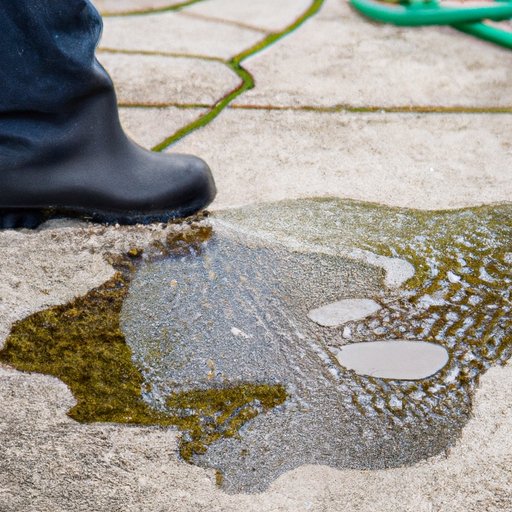
Introduction
Oil stains on concrete can be unsightly and difficult to remove, especially if left untreated. They can make your driveway, garage, or patio look dirty and uninviting. If you are looking for effective and affordable ways to remove oil stains from concrete, you have come to the right place. In this article, we’ll discuss various DIY methods, pressure washing, chemical cleaners, natural solutions, prevention tips, and hiring professionals to help you remove oil stains from your concrete surfaces.
This article is for anyone who wants to learn how to remove oil stains from concrete, including homeowners, renters, business owners, and anyone who wants to keep their property clean and presentable.
DIY Methods
There are several do-it-yourself methods you can use to remove oil stains from concrete. Some of the most popular include:
Baking Soda and Vinegar
Mix a half-cup of baking soda with enough white vinegar to form a paste. Apply the paste to the stained area and let it sit for 15-20 minutes. Then, scrub the area with a bristle brush and rinse with water.
Dish Soap
Squirt a few drops of dish soap onto the oil stain and add hot water. Scrub the area with a stiff-bristled brush and rinse with water.
Cat Litter
Apply cat litter to the stained area and let it sit for a few days until the oil is absorbed. Sweep away the litter and rinse the area with water.
These methods are affordable, easy to use, and can be found in most households. However, these methods may not be effective for stubborn or old oil stains.
Pressure Washing
Pressure washing is an effective way to remove oil stains from concrete, especially for larger and more stubborn stains. However, it’s important to use the right pressure, nozzle, and techniques to avoid damaging the concrete surface.
Here are some tips for pressure washing:
- Use a pressure washer with a minimum of 3000 PSI (pounds per square inch) and a flow rate of at least 4 gallons per minute.
- Use the 15-degree nozzle or the rotary nozzle for concrete surfaces.
- Adjust the pressure to avoid damaging the surface. Test the pressure on a small area first.
- Maintain a distance of 6-12 inches between the nozzle and the surface.
- Wear protective gear such as gloves, goggles, and boots.
Pressure washing can be effective, but it can also be dangerous if not done properly. Make sure to follow proper safety precautions and techniques, or consider hiring a professional pressure washing service.
Chemical Cleaners
If DIY methods and pressure washing are not effective, you can try using chemical cleaners such as degreasers or concrete-specific cleaners. These products are designed to break down oil and grease, making it easier to remove them from the surface.
When using chemical cleaners, it’s important to follow safety guidelines, such as:
- Wearing protective gear such as gloves, goggles, and boots.
- Reading the manufacturer’s instructions carefully.
- Mixing and applying the product in a well-ventilated area.
- Disposing of leftover product and containers properly.
Chemical cleaners can be effective, but they can also be hazardous to your health and the environment. Use them with caution and as a last resort.
Natural Solutions
If you prefer natural and eco-friendly solutions, you can try using plant-based absorbents such as cornstarch, sawdust, or activated charcoal. These materials can pull the oil out of the concrete surface, making it easier to remove the stain.
Here are some natural solutions you can try:
Cornstarch
Apply cornstarch to the oil stain and let it sit for a few hours or overnight. Sweep away the cornstarch and rinse the area with water.
Sawdust
Apply sawdust to the stained area and let it sit for a few days until the oil is absorbed. Sweep away the sawdust and rinse the area with water.
Activated Charcoal
Apply activated charcoal to the oil stain and let it sit for a few hours or overnight. Sweep away the charcoal and rinse the area with water.
These natural solutions are affordable, eco-friendly, and safe to use. However, they may not be as effective as chemical cleaners or pressure washing for larger or older stains.
Prevention
Prevention is the best way to avoid oil stains on your concrete surfaces. Here are some prevention tips you can follow:
- Use drip pans under your car or equipment to catch oil and grease.
- Absorb spills and leaks immediately with cat litter or paper towels.
- Use mats or rugs in high-traffic or spill-prone areas.
- Clean your concrete surfaces regularly with water and a mild detergent.
By following these tips, you can reduce the risk of oil stains on your concrete surfaces and save yourself time and money in the long run.
Hiring Professionals
If DIY methods, pressure washing, and chemical cleaners are not effective, or if you have large or stubborn oil stains on your concrete surfaces, you may need to hire a professional cleaning service. Make sure to do your research and hire a reputable and experienced professional who uses eco-friendly and safe cleaning methods.
When hiring a professional, look for:
- Certification and licensing
- Experience and references
- Eco-friendly and safe cleaning methods
- Transparency and communication
A professional cleaning service can help you remove oil stains from your concrete surfaces quickly and effectively, saving you time, money, and hassle.
Conclusion
Removing oil stains from concrete can be challenging, but it’s not impossible. By using DIY methods, pressure washing, chemical cleaners, natural solutions, prevention tips, or hiring professionals, you can effectively remove oil stains from your concrete surfaces and keep them clean and presentable. Remember to follow safety guidelines, use the right tools and techniques, and seek professional help if necessary. By taking proactive and preventive measures, you can reduce the risk of oil stains and enjoy clean and beautiful concrete surfaces for years to come.




